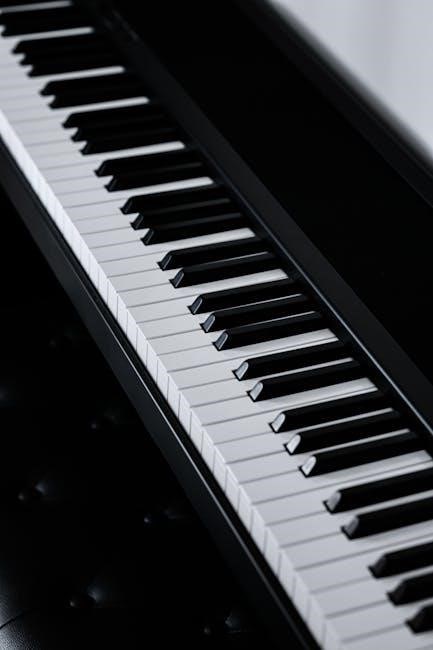Major and minor scales are foundational in piano music‚ forming the backbone of Western music theory. They provide the framework for chords‚ melodies‚ and harmonies. Major scales create a bright‚ uplifting sound‚ while minor scales evoke a more somber or introspective mood. Understanding these scales is essential for pianists‚ as they are used extensively in compositions and improvisations. The internet offers numerous resources‚ including downloadable PDFs‚ to help musicians learn and practice major and minor scales effectively.
1.1 What Are Major Scales?
Major scales are a series of notes arranged in a specific pattern of whole and half steps‚ creating a bright‚ uplifting sound. Each major scale consists of seven distinct notes‚ with the eighth note repeating the first at a higher octave. The pattern of whole and half steps in a major scale is W-W-H-W-W-W-H. For example‚ the C Major scale includes the notes C‚ D‚ E‚ F‚ G‚ A‚ B‚ and C. Major scales are fundamental in music theory and serve as the basis for many compositions and improvisations. They are widely used in various musical genres due to their harmonious and resonant quality.
1.2 What Are Minor Scales?
Minor scales are sequences of notes that create a distinct‚ often somber or introspective sound. They follow a specific pattern of whole and half steps‚ differing from major scales. The natural minor scale‚ for example‚ has the pattern W-H-W-W-H-W-W. Minor scales can also be harmonic or melodic‚ with variations in their intervals. They are commonly used to evoke emotional depth in music. For instance‚ the A Natural Minor scale includes the notes A‚ B‚ C‚ D‚ E‚ F‚ G‚ and A. Minor scales are essential in piano music‚ offering a contrasting mood to major scales while sharing the same key signature.
1.3 Importance of Scales in Piano Music
Scales are fundamental to piano music‚ serving as the building blocks for melodies‚ harmonies‚ and chords. They enhance technical proficiency‚ improve sight-reading skills‚ and foster musical understanding. Mastery of major and minor scales allows pianists to interpret compositions accurately and expressively. Scales also aid in developing finger dexterity‚ strength‚ and coordination. Additionally‚ they provide a framework for improvisation and composition‚ making them indispensable for pianists at all skill levels. Regular practice of scales is essential for progress and artistry in piano performance.

Structure of Major Scales
Major scales follow a specific pattern of whole and half steps: W-W-H-W-W-W-H. This sequence creates the distinctive sound of major scales on the piano.
2.1 Whole and Half Steps in Major Scales
Major scales are built using a specific sequence of whole and half steps. A whole step spans two semitones‚ while a half step is just one semitone. For example‚ C to D is a whole step‚ and D to E is another whole step. This pattern of whole and half steps (W-W-H-W-W-W-H) creates the distinctive sound of a major scale. Understanding these intervals is crucial for constructing and playing major scales correctly on the piano‚ as they form the foundation of Western music theory and chord structures.
2.2 The Major Scale Pattern
The major scale pattern follows a consistent sequence of whole and half steps: W-W-H-W-W-W-H. This pattern applies to all major scales‚ ensuring a uniform structure. For example‚ the C major scale—C-D-E-F-G-A-B-C—demonstrates this pattern clearly. By mastering this sequence‚ pianists can construct any major scale starting from a given root note. This pattern is fundamental to understanding key signatures‚ chord progressions‚ and the harmonic framework of music.
2.3 How to Play Major Scales on the Piano
To play major scales on the piano‚ start with the root note and follow the W-W-H-W-W-W-H pattern. Use proper fingerings to ensure smooth transitions between notes; Begin with a slow tempo and gradually increase speed as you build confidence. Practice hands separately before combining them. Pay attention to dynamics and articulation for a polished sound. Utilize metronomes to improve timing accuracy. Downloadable PDF resources‚ such as scale charts with fingerings‚ are available online to aid practice and mastery of major scales effectively.

Structure of Minor Scales
Minor scales consist of unique patterns of whole and half steps‚ differing from major scales. They include natural‚ harmonic‚ and melodic forms‚ each with distinct intervals and emotional qualities.
3.1 Natural Minor Scales
Natural minor scales‚ also known as Aeolian mode‚ follow the interval pattern of whole and half steps: W-H-W-W-H-W-W. This creates a distinct‚ somber sound. They are commonly used in compositions to evoke introspective emotions. Unlike harmonic and melodic minors‚ natural minors do not alter any notes‚ making them a fundamental starting point for understanding minor tonalities. Resources like PDFs provide fingering diagrams and note sequences for all natural minor scales‚ aiding pianists in their practice and mastery of these essential scales.
3.2 Harmonic Minor Scales
Harmonic minor scales are a variation of natural minor scales with a raised 7th scale degree‚ creating a distinctive interval pattern of W-H-W-W-H-WH-H. This alteration produces a brighter‚ more dramatic sound often used in musical compositions to add tension; The raised 7th degree facilitates certain harmonic functions‚ such as leading tones in chord progressions. Resources like PDFs offer detailed fingerings and note sequences for harmonic minor scales‚ helping pianists master their unique structure and emotional impact in various musical contexts.
3.3 Melodic Minor Scales
Melodic minor scales are a unique variation used in both classical and jazz music. They ascend with a raised 6th and 7th scale degree‚ creating a distinct interval pattern of W-H-W-W-W-W-H‚ but descend like the natural minor scale. This dual nature provides a rich‚ emotional sound. The raised notes in the ascending scale add tension and color‚ making it ideal for expressive melodies. PDF resources often include melodic minor scales‚ offering detailed fingerings and practice exercises for pianists to master this versatile and elegant scale.

The Circle of Fifths
The Circle of Fifths is a visual tool showing the relationship between major and minor keys‚ arranged in perfect fifths. It aids in understanding key signatures‚ harmonization‚ and transposition‚ linking major and minor keys in a harmonic structure.
4.1 How the Circle of Fifths Works
The Circle of Fifths is a circular diagram that organizes musical keys‚ with each key positioned a perfect fifth apart. Starting from C‚ keys progress clockwise‚ adding sharps‚ while counterclockwise adds flats. This tool visualizes the relationships between major and relative minor keys‚ showing how they share the same key signature. It simplifies understanding key signatures‚ chord progressions‚ and transposition‚ making it an essential resource for pianists and composers to navigate harmonic structures efficiently.
4.2 Major and Minor Keys in the Circle of Fifths
The Circle of Fifths maps major and relative minor keys‚ showing their relationships. Each major key is paired with a minor key sharing the same key signature. Moving clockwise adds sharps‚ while counterclockwise adds flats. For example‚ C Major and A Minor are relatives. This circular arrangement helps pianists understand key relationships‚ transposition‚ and modulation‚ making it easier to identify chords and scales in different keys. It’s a visual tool that simplifies harmonic connections and enhances musical understanding and composition.

Diatonic Chords in Major and Minor Scales
Diatonic chords are built from the notes of a major or minor scale‚ creating harmonically rich sounds. They form triads‚ sevenths‚ and extensions‚ essential for composition and improvisation. PDF resources provide chord charts and fingerings for pianists to practice scales and chords effectively‚ enhancing musical understanding and performance.
5.1 Building Chords from Major Scales
Chords are constructed by stacking thirds from the notes of a major scale. Each scale degree forms a triad (major‚ minor‚ or diminished) based on the interval pattern. For example‚ the tonic chord is a major triad‚ while the supertonic is minor. Seventh chords are created by adding a fourth note‚ a minor seventh above the root. These diatonic chords are fundamental for harmony and composition. PDF resources provide chord charts and fingerings‚ helping pianists practice and apply these chords effectively in their music.
5.2 Building Chords from Minor Scales
Chords built from minor scales follow a similar process to major scales but with different interval patterns. Natural minor scales produce distinct triads‚ with the tonic being a minor chord‚ the supertonic diminished‚ and the mediant a major chord. Seventh chords are formed by adding a minor seventh above the root. Harmonic and melodic minor scales introduce altered tones‚ creating varied chord possibilities. PDF resources provide detailed charts and fingerings‚ enabling pianists to explore these chords and their harmonic applications in music composition and performance.
Fingerings for Major and Minor Scales
Right-hand and left-hand fingerings for major and minor scales are provided in PDFs‚ ensuring proper finger placement and technique. These resources help pianists master scale execution effectively.
6.1 Right-Hand Fingerings for Major Scales
Right-hand fingerings for major scales are designed to ensure smooth‚ even execution. Start with the thumb (1) on the tonic note‚ followed by fingers 2‚ 3‚ and 4. The pinky (5) is used sparingly. For example‚ in C Major‚ the right-hand fingering is 1-2-3-4-5-4-3-2-1. This pattern adapts to all major scales‚ with adjustments for sharps and flats. PDF resources often include visual diagrams‚ making it easier to learn and practice. Proper finger placement enhances dexterity and maintains a consistent tone while playing major scales on the piano.
6.2 Left-Hand Fingerings for Minor Scales
Left-hand fingerings for minor scales emphasize a balanced approach to maintain evenness and control. Typically‚ the fifth finger (pinky) starts on the tonic‚ followed by fingers 4‚ 3‚ 2‚ and 1. For example‚ in A Minor‚ the fingering is 5-4-3-2-1-2-3-4-5. This allows for smooth transitions between notes. PDF guides often provide detailed diagrams‚ helping pianists master finger placement. Proper left-hand technique ensures clarity and precision when performing minor scales‚ enhancing overall musicality and expression.

Printable Major and Minor Scale PDFs
Downloadable PDFs provide clear layouts of major and minor scales‚ including note letters‚ fingerings‚ and key signatures. Ideal for practice‚ these resources are organized by key.
7.1 Major Scale PDFs
Major scale PDFs are available for all keys‚ offering note sequences‚ fingerings‚ and visual layouts. Many feature right and left-hand fingerings separately‚ with clear enharmonic equivalents listed. These resources are designed for pianists to practice efficiently‚ ensuring proper technique and clarity. Printable formats allow musicians to access scales anywhere‚ making practice convenient and organized; The PDFs cover keys like C Major‚ G Major‚ D Major‚ and more‚ providing a comprehensive learning tool for mastering major scales on the piano.
7.2 Minor Scale PDFs
Minor scale PDFs provide detailed note sequences for natural‚ harmonic‚ and melodic minors. These resources cover all keys‚ such as A Minor‚ E Minor‚ and B Minor‚ with clear fingerings for both hands. Enharmonic equivalents are included for ease of understanding. The PDFs are designed for personal use‚ offering a structured approach to learning and practicing minor scales. They often feature visual layouts that help pianists master the scales efficiently‚ ensuring proper technique and musicality. These tools are invaluable for musicians seeking to expand their repertoire;

Tips for Practicing Scales
Set specific goals‚ practice slowly‚ and use a metronome. Focus on finger independence‚ dynamics‚ and articulation. Avoid rushing and ensure proper hand positioning for optimal results.
8.1 Effective Practice Techniques
Set specific‚ achievable goals for each practice session. Use a metronome to improve timing and gradually increase speed. Practice scales hands separately before combining them. Start with a slow tempo to ensure accuracy and build muscle memory. Break scales into smaller sections to master challenging passages. Focus on smooth transitions between notes and maintain consistent dynamics. Incorporate varying articulations‚ such as legato and staccato‚ for diversity. Record yourself to identify areas for improvement. Utilize downloadable PDF resources for clear fingering guides and structured practice routines. Regular‚ focused practice yields steady progress and mastery of scales.
8.2 Common Mistakes to Avoid
When practicing scales‚ avoid rushing through notes without ensuring accuracy. Inconsistent fingering can lead to technical difficulties and uneven playing. Neglecting dynamics and articulation results in a lack of musicality. Playing scales in a monotone manner fails to develop expression. Inadequate slow practice hinders mastery before increasing speed. Ignoring finger stretches and position changes can cause discomfort and errors. Failing to record and review performances prevents identifying flaws. Relying solely on muscle memory without understanding scale structure limits versatility. Address these mistakes with focused‚ deliberate practice to achieve polished scale performances.
